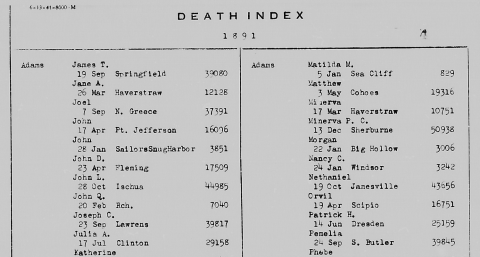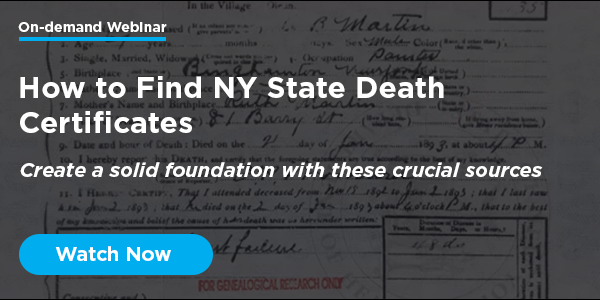Whether you’re just getting started or trying to break through a longtime brick wall, we have a suggestion for you—make sure you have your ancestor’s New York death certificate.
It’s one of the most important records to have, and can be instrumental in making future discoveries.
Finding New York death records can be challenging due to the complex history of birth, marriage, death records in New York, but it's not so hard with a little guidance.
Whether your ancestor is from New York City or elsewhere in New York State the truth of the matter remains the same—you really need to find their death certificate!
Read on to see why it's the first vital record you should seek, what you can learn from it, and where to look for clues to locating it.
If you're ready to find that death certificate right away, head to our free subject guide to Finding New York Birth, Marriage, and Death Records—it's is an excellent jumping-off point once you’re ready to search.
1. It's often the most recent record
This one may seem obvious, but it’s important. A death certificate is one of the last records generated by every individual.
If you’ve been doing genealogy for a while, you have likely heard many experts and educators give you the well-regarded guidance to work backwards.
If this is the first time you’ve heard this advice, take it to heart: It’s the key to creating a sound foundation for your family tree.
The reason it’s so important to work backwards is to ensure you don’t make mistakes. If you were building a tower, you would start by lying a solid, stable foundation that keeps everything above it from tumbling down.
The same principle applies to genealogy—the way to create the most correct and satisfying family tree is to work backwards and definitively prove each generation is connected to the previous one.
The most recent generation forms the foundation for your family tree and further research. When you exhaustively research a generation, not only does it become far easier to find records for the previous generation, you're far less likely to wind up researching the wrong people.
Countless genealogists have wasted years researching a wrong family line due to tackling their research in the wrong order—don’t be one of them!
When you’re researching a single individual, it’s also best to work backwards—just like an obituary, the death record is one of the few records that can capture all other life events that happened before it, because all life events occur before a death certificate is made.
2. Of all vital records, death certificates have the highest chance of existing
Unlike many other states, New York birth, marriage, and death records can be challenging to find.
Towns and cities didn’t always comply with record keeping laws until the early 1900s, and New York City vital records are kept entirely separate from those that belong to people from other areas of New York State.
The opening section of our Guide to Finding New York Birth, Marriage, and Death Records has more detail on this interesting (but frustrating!) subject.
The good news is that of the types of vital records—birth certificates, marriage records, and death certificates—New York death certificates are often the easiest to find.
As a general rule, vital record keeping across the state gradually improved over time. Therefore, no matter when your ancestor lived, record keeping was far better when they died than when they were born, in almost all cases.
That’s certainly no guarantee an official New York death certificate exists, but it’s usually safe to assume it’s the more likely to exist than a birth or marriage record (not to mention the fact that not everyone got married!).
3. Information on death certificates can jump-start your research
Most official New York death certificates from the 1900s and later will contain a wealth of information that will make it much easier to find more records on your ancestor.
However, it’s important to note that the information available on a death certificate will vary depending on the time period in which it was created.
New York death certificates can contain the following information:
- Birth date (or age)
- Birth place
- Name of spouse
- Names of parents
- Length of residence in the state or county
- Death details (cause, location, burial, etc)
- Informant’s name (the person who supplied this information)
Because a death certificate is created at the conclusion of an individual’s life, it is well positioned to capture information on a wide variety of life events. After all, by definition, every single life event happens before a death certificate is made.
Once you have a death certificate, you’re armed with excellent leads to investigate more life events of the individual—whether it’s a birth, marriage, or place of residence.
4. You might need a death certificate to obtain permission to access other records
Aside from the genealogical information, a death certificate is often a very handy tool to have in your arsenal, because it could quite literally be the key to unlocking more records—in your research, you may need to submit proof that an individual has died in order to obtain records about their life.
For instance, researchers seeking birth certificates and marriage records for ancestors who lived in New York State (outside of New York City) will need to submit proof of death in order to obtain these records.
For New York State birth certificates, researchers need to prove the individual is deceased. For marriage records, researchers need to prove that both spouses are deceased.
A similar example applies to those researching New York City—you will need to submit proof that both spouses have died if seeking a marriage record less than 50 years old.
This reason alone should be enough to motivate you to find that death certificate—there’s nothing more frustrating than finding the exact birth or marriage certificate you’re seeking, only to realize that you need to hunt down a whole other record in order to be allowed to access it.
5. Some death certificate extracts exist online
Fortunately for researchers, New York death certificates are mostly possible to find online. For individuals outside of New York City, researchers should first consult that New York State Death Index (searchable on Ancestry.com, and free to browse on Archive.org and the NYG&B website).
After finding your ancestor in this index, you can order a copy from the State Archives in Albany, though the wait time for the full certificate can be extensive. It may also be possible to find a copy of the certificate from a more local municipality. For more guidance on this, see our Guide to Finding New York Birth, Marriage, and Death Records.
Those researching ancestors who died in New York City can hope to find more immediate success. Several online indexes are available, and the most robust can be found on Ancestry.com.
This index comes with a significant amount of extracted information from each certificate, including many of the pieces of information that make a death certificate so worthy of finding in the first place. You can read more about the exact coverage in our article about these new collections when they debuted, New NYC Birth, Marriage, and Death Indexes Now Available.
And of course, our Guide to Finding New York Birth, Marriage, and Death Records has links to all other New York City Death Indexes. Full certificates can also be ordered from New York City, and wait times are not as long as those ordered from the State Archives in Albany.
What if I’ve tried to find a death certificate and can’t?
There are many good reasons that you simply might not be able to find an official New York death certificate. If you have performed a reasonably exhaustive search, and still come up empty, don’t fear!
It’s a good idea to do one last review of New York death certificate record keeping practices—start with our Guide to Finding New York Birth, Marriage, and Death records just to make sure you aren’t looking in the wrong index, or haven’t missed another crucial detail in New York’s complicated vital records landscape.
If you’re still having no luck, there is some good news—there are plenty of substitutes for New York death certificates.
You may want to try searching for New York religious records, especially if your ancestor died prior to the mid 1800s—before that time, many municipalities in New York viewed vital record keeping as a function of the church, not the state. Read our blog about using New York religious records as vital record substitutes.
Researchers should also consider searching for an ancestor’s obituary. While not an official state document, the obituary can provide similar information to that of a death certificate, and may even contain more detail—after all, obituary writers were not bound by fields on official documents. Read our blog about obituaries for some tips on finding your ancestor’s obituary.

